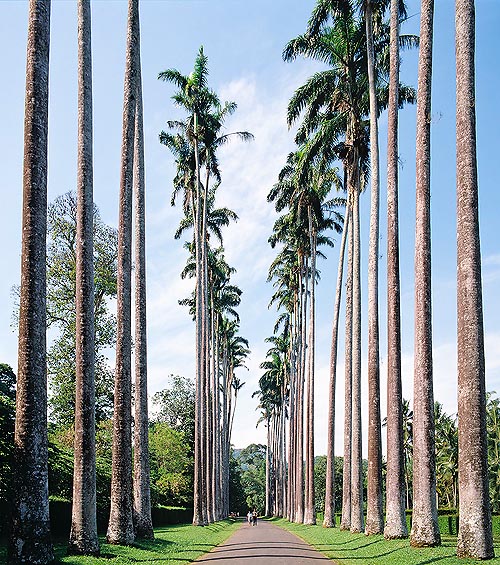Family : Arecaceae

Text © Pietro Puccio

English translation by Mario Beltramini

30 m tall with 60 cm of diametre for spectacular avenues in the Tropics © G. Mazza
The Roystonea oleracea (Jacq.) O. F. Cook (1901) is native to Barbados, Dominica, Guadeloupe, Martinique, Trinidad & Tobago, Venezuela and Colombia, where it grows both in the humid forests and in the savannas in areas usually swampy.
The genus gets the name from the General of the US Army Roy Stone (1836-1905), who worked as engineer in Puerto Rico ; the Latin name of the species “oleraceus” = looking like a vegetable, which refers to the edible vegetative apex.
The names with which it is more commonly known are: “cabbage palm”, “Caribbean royal palm”, “South American royal palm” (English); “palmier colonne”, “oréodoxe des Caraïbes”, “palmier royal des Caraïbes”, “palmiste franc” (French); “Kohlpalme” (German); “chaguaramo”, “palmeira imperial”, “mapora” (Spanish); “palmeira real”, “palmeira-de-Cuba” (Portuguese).
It shows a single stem, smooth, imposing, of greyish colour, with a maximum height of more than 30 metres, and a diameter of about 60 cm; the foliar base, smooth and of bright pale green colour, wraps entirely the stem for a height of 1,5 metres, forming a sort of elegant capital. The leaves are pinnate, long about 4 metres, with glossy dark green leaflets regularly inserted on the rachis, long up to 80 cm. The inflorescences, very ramified, develop under the leaves and carry small flowers of both sexes. The fruits are globose, of about 16-18 mm of length, of dark purple colour. The seeds germinate in about 2 months.
It is a palm of great landscape effect due to its grandiosity and elegance and is frequently cultivated in the tropical and subtropical countries, where is often utilized both as isolated plant and as tree along the roads and the avenues. The cultivation in areas with warm temperate climate can be also tried, in full sun, as it resists to temperatures close to the 0 °C only for short periods.
Synonyms : Areca oleracea Jacq. (1763); Oreodoxa oleracea (Jacq.) Mart. (1838); Kentia oleracea (Jacq.) Seem. ex H.Wendl. (1878); Gorgasia oleracea (Jacq.) O.F.Cook (1939); Euterpe caribaea Spreng. (1825); Oreodoxa caribaea (Spreng.) Dammer & Urb. in I.Urban, (1903); Roystonea caribaea (Spreng.) P.Wilson, (1917); Oreodoxa regia var. jenmanii Waby (1919); Roystonea oleracea var. excelsior L.H.Bailey (1935); Roystonea venezuelana L.H.Bailey (1949); Roystonea oleracea var. jenmanii (Waby) Zona (1996).
→ For general notions about ARECACEAE please click here.
